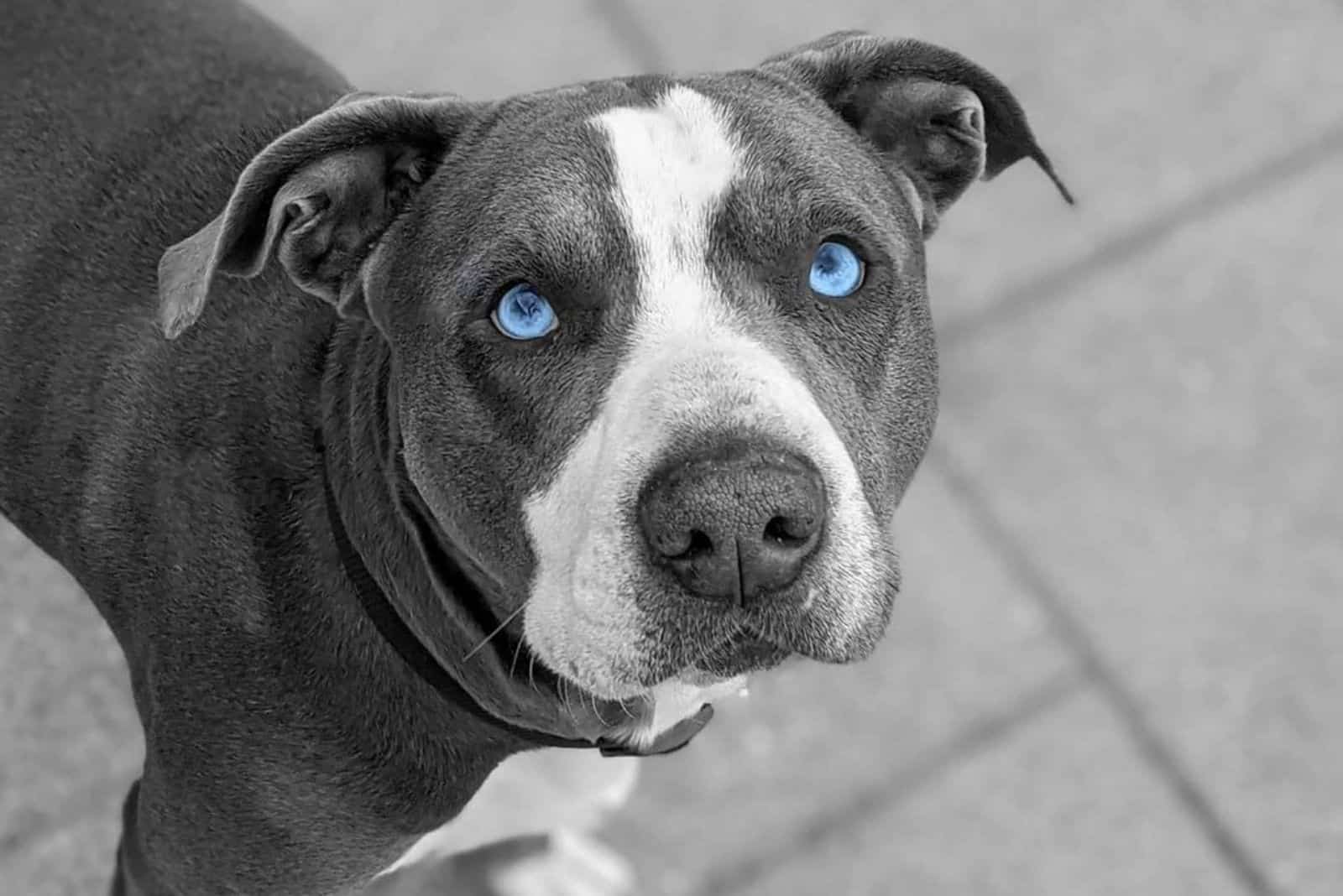The United Kennel Club (UKC) says that the American Pit Bull Terrier (APBT) is a result of breeding an Old English Bulldog and a Terrier to get a dog that has the strength of the bulldog and the agility of the terrier breed.
The Pitbull Terrier gained popularity in Britain for the bloody sport of bull baiting where one to two APBT dogs were set to harass a bull for hours until the animal collapsed from fatigue or injuries.
When bull baiting was outlawed, the APBT was used for dogfighting and ratting. Still, bloody sports.
Immigrants to America brought this bull and terrier mix. As the bloody sports became unpopular and outlawed, Pitbulls became farm dogs and companions.
Today, Pitbulls battle bad publicity, but they’re genuinely kind dogs with big hearts full of love.
Blue Eyed Pitbull Full Grown: Personality And Temperamenť
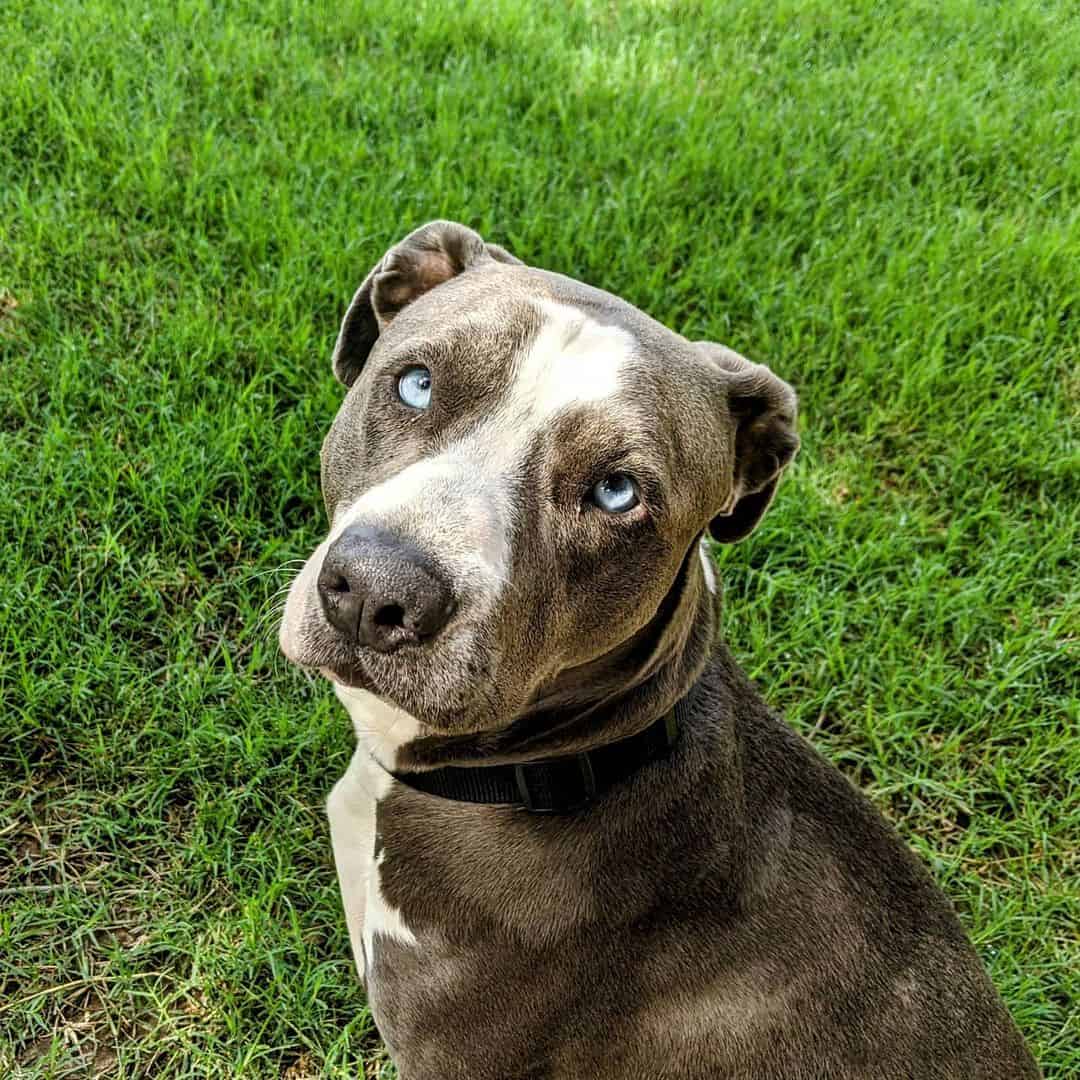
Photo from: @gonzobuddy
Pitbulls or Pitties are loyal and protective dogs on the athletic side of the canine kingdom.
Despite that negative publicity and lots of stereotypes associated with this breed, studies have proven that Pitties are one of the most affectionate and tolerant dogs. In fact, they’re one of the least aggressive dogs ever!
Pitbulls aren’t aggressive with people, but they seem to be less tolerant of other dogs.
Still, Pitbulls are enthusiastic pets that love to please their owners. No wonder why many call them nanny dogs!
Pitbulls are stubborn and tenacious dogs. Being fearless is one of their biggest traits. This breed isn’t the best choice for first-time owners. They need an experienced hand to curb their disobedient behavior. Get your Pitbull proper training, care, and top-quality dog food, and you’ll have a healthy Pitty for years to come.
Are Blue-Eyed Pitbulls Rare? Why Do Pitbulls Have Blue Eyes?
Let’s crack the code behind those stunning blue eyes!
The default eye color for most dogs is brown. However, genetics, pigmentation, and health issues are the main contributors as to why a Pitbull may alter eye colors. Genetics is the number one choice for those piercing blues.
If blue eyes run in your puppy’s family, it’s most likely that your Pitbull will be a blue-eyed Pitbull. Such Pitbulls are truly rare and stunning.
What Is The Merle Gene?
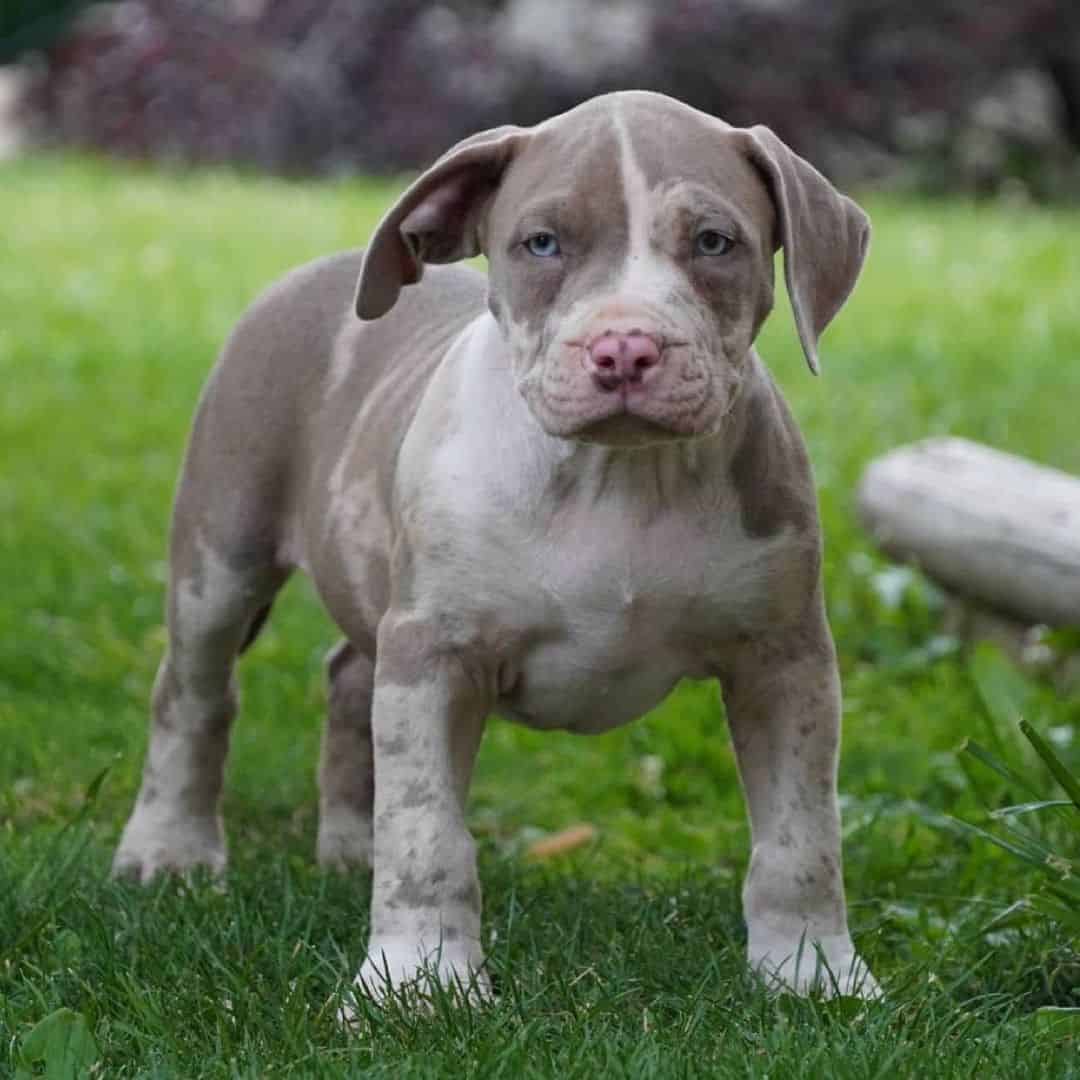
Photo from: @merlebulliesofig
Pitbulls that carry the merle gene (M-locus) are more likely to have blue eyes. This merle gene is responsible for random pigment dilution (lightening) of the eyes, and also the nose and hair.
However, being a carrier of the gene doesn’t guarantee that all the puppies will have blue eyes. It takes both parents to carry this gene in order to increase the chance of blue eyes, but even then, it’s still not 100% sure.
What Is The ALX4 Gene?
One study that included 6,000 dogs and their complete genetic profiles, carried out by Embark Veterinary DNA Testing Company, discovered that a genetic mutation near the gene known as ALX4 is also responsible for blue eyes in dogs.
Pitbulls carrying this mutation are more likely to develop blue eyes.
How Do Melanin Levels Affect Eye Color?
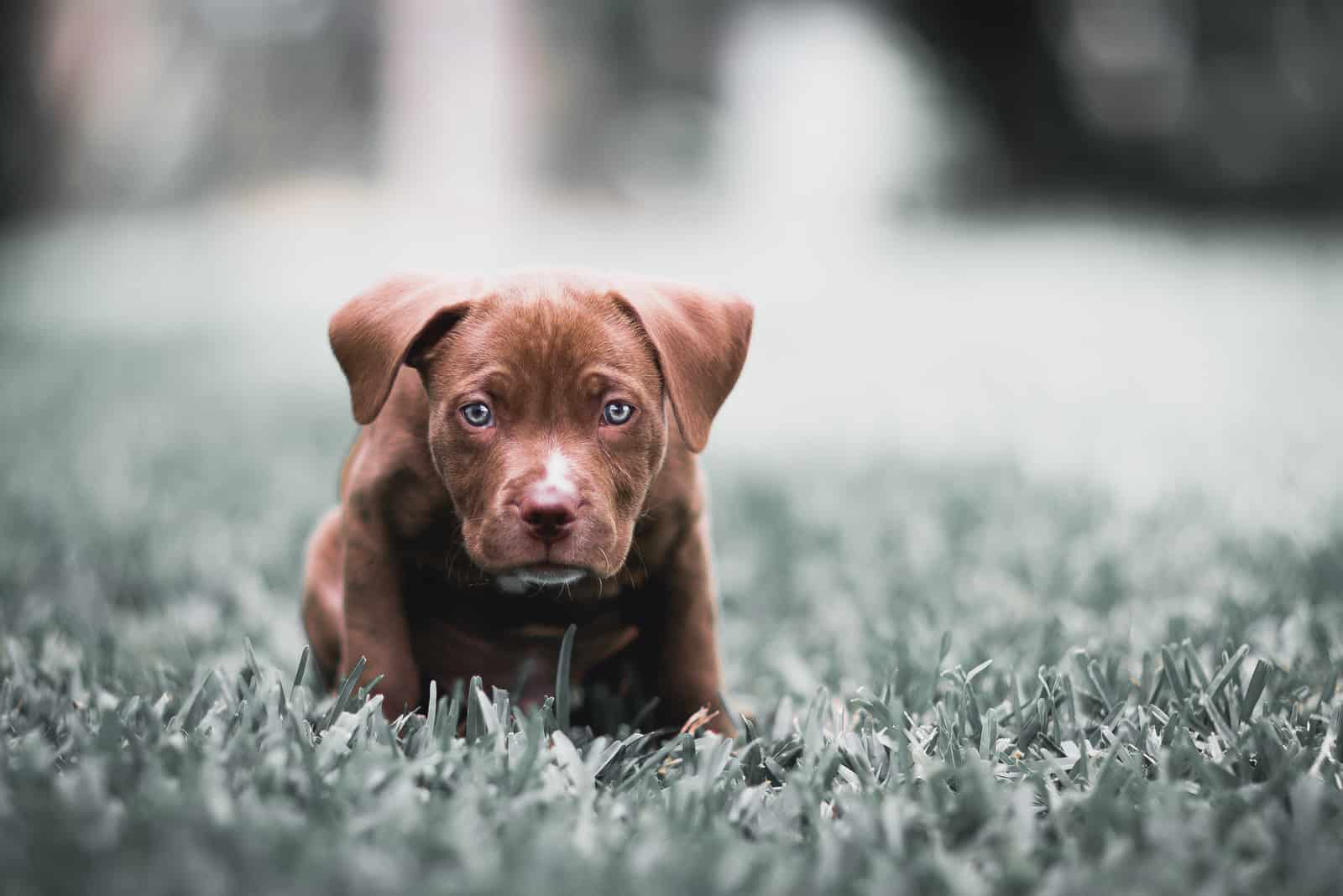
Melanin levels also affect eye color in Pitbulls.
Melanin is a pigment found in the iris, and it is another factor that determines the eye color of dogs.
Dogs with a higher level of melanin in their iris have brown eyes.
The lower the melanin concentration is, the lighter your dog’s eye color will be.
How Do Pitbulls Get The Blue Eye Color?
The gene that is known as the M (merle locus) gene modifies eumelanin, the black pigmentation in melanin.
This genetic modification results in pigment loss, which creates eye colors like pale brown and others shaded all the way to the blue eye color shade.
Blue-Eyed Pitbull’s Health Issues
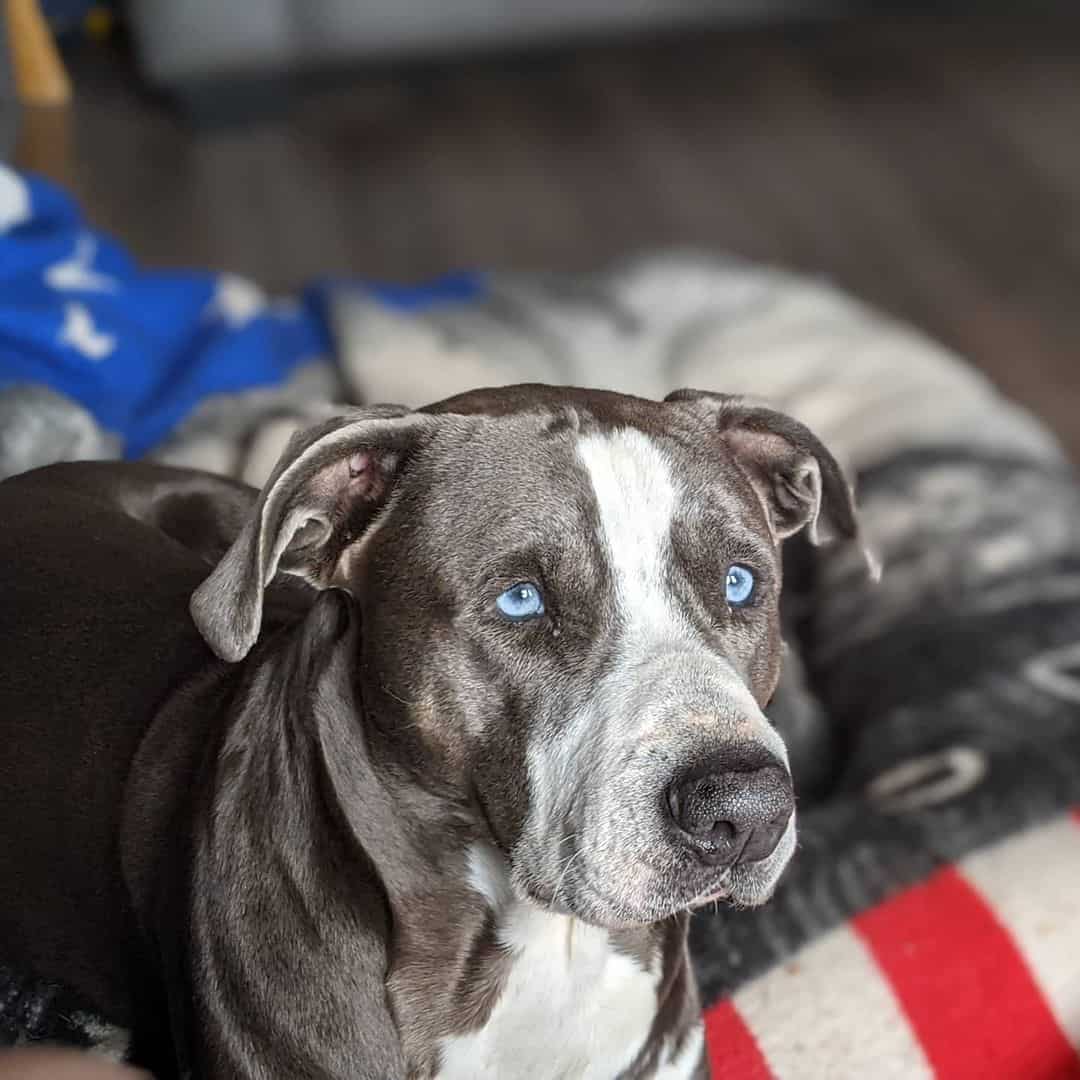
Photo from: @gonzobuddy
Being a blue-eyed Pitbull doesn’t mean that your dog will suffer from any specific health issues. Blue eyes in dogs are not linked with health issues at all. You can have a perfectly healthy blue-eyed Pitbull.
However, blue eyes may increase the possibility of getting certain health problems that brown-eyed dogs don’t usually get.
Blue-eyed Pitbulls are prone to developing the following health problems:
Deafness: According to Washington State University, blue-eyed Pitbulls are linked to hearing problems. This breed is among the breeds that are predisposed to congenital deafness.
In fact, dogs with white or merle coats are also predisposed to congenital deafness. However, not all white or merle Pitbulls may be deaf or be prone to partial or complete deafness.
Deafness is present in some dog breeds that carry the merle and piebald genes. Congenital deafness is linked to the merle gene, while the piebald gene is linked to spotted or multicolored dog coats. The piebald gene can cause deafness due to a lack of mature melanocytes (melanin-producing cells) within the inner ear.
If your Pitbull is a blue-eyed one (because of the merle gene) or has a spotted coat color (because of the piebald gene) or white gene, then it may have a higher risk of hearing loss.
To rule out congenital deafness, conducting a test known as the BAER would be great. Pitbull puppies as young as six weeks of age may be tested.
If your Pitbull is already deaf, then we advise you to learn how to communicate with your dog as well as you can.
It’s recommended to rule out congenital deafness by getting a collar for deaf dogs and a dog ID tag.
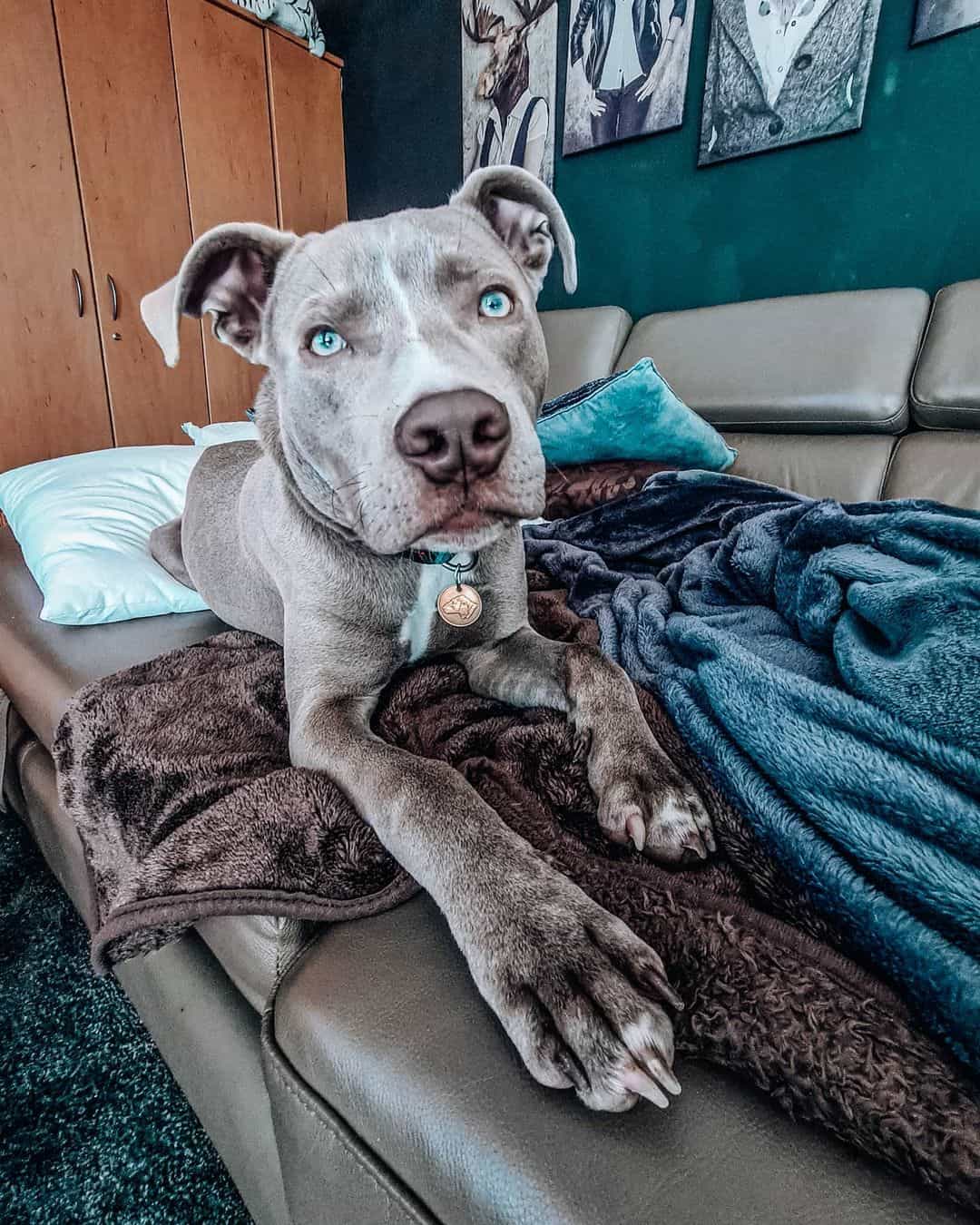
Photo from: @mr.melu
Blindness: This affects Pitbulls with blue eyes. Blue eyes in dogs may be a sign that your pet has a merle gene or a dominant gene.
However, this doesn’t mean that a blue-eyed Pitbull will eventually go blind. A puppy may go blind only if both parents carry the merle gene and pass it on. Dogs that are double merle, which means that they have two copies of the merle (M/M) trait, are predominantly white and prone to numerous health issues.
Albinism: Pitbulls that lack the genes necessary to produce melanin (the pigment responsible for skin, eye, and hair coloring) could suffer from albinism.
A gene such as the “M (merle locus) gene” modifies eumelanin (the black melanin pigment in dogs), which results in pigment loss, and a massive loss of this pigment throughout a dog’s entire body can result in albinism.
Most of the dog breeds that suffer from congenital deafness have some white pigmentation in their coats.
Other Eye Health Problems
PitBulls can also have eye conditions, such as:
• Hereditary cataracts
• Distichiasis (double eyelashes)
• PHPV (Persistent Hyperplastic Primary Vitreous)
Are Those Blue Eyes Really Blue?
Well, their eyes may look blue, but they really aren’t. Here’s a valid explanation!
Pitbulls, or any dog breed with blue eyes, don’t have blue eyes according to Geneticist Kristopher Irizarry of the College Of Veterinary Medicine at Western University of Health Sciences.
Dogs with blue eyes have completely different and colorless irises without pigment, unlike their buddies with brown eyes. Blue eyes get their color the same way that water in the eyes gets it. The light that enters the Pitbull’s eyes is scattered back into the atmosphere, resulting in those piercing baby blues.
Pretty awesome, isn’t it?
Blue-Eyed Pitbulls vs Brown-Eyed Pitbulls
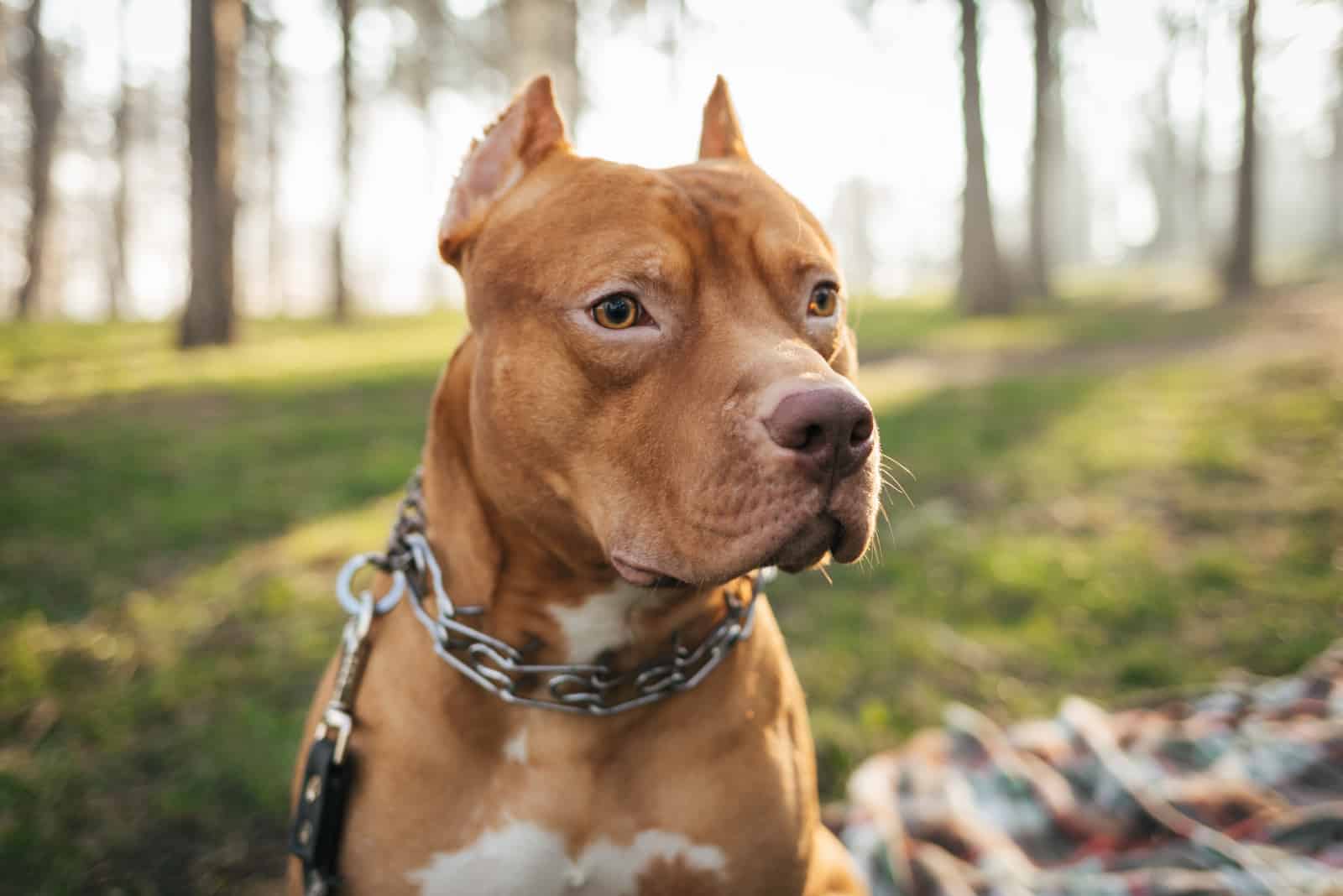
The biggest difference between blue-eyed Pitbulls and their buddies with brown eyes is, of course, the color of their eyes.
Generally speaking, all Pitbulls have a muscular build and a short and smooth coat in lots of different colors. Pitbulls are active and athletic dogs, with a short, almost whip-like tail that ends in a point. Their wide and square-like head and jaws are the trademark of all Pitbulls.
Male Pitbulls can grow up to 11 to 13 inches tall, and weigh between 20 and 28 pounds. Unlike many other purebred dogs, female Pitbulls are almost the same height and weight as males. The biggest differences are those between different Pitbull types, i.e., Bulldogs and Terriers.
Blue-Eyed Pitbull Eye Color Characteristics
According to the United Kennel Club’s breed standard for Pitbulls, Pitbulls have round, medium eyes set well apart and low on the skull.
All eye colors are acceptable but one. Unfortunately, our Pittie of the day, the blue-eyed Pitbull, is considered a serious flat.
Pitbulls aren’t common carriers of the piebald and merle gene or even blue-eye-causing genes. Experts claim that a Pitbull with blue eyes might not be purebred because those genes must have somehow found a way into the bloodline.
The only acceptable colors range from very dark brown to dark hazel and green eyes.
Do Blue Eyes Have Something To Do With Coat Color?
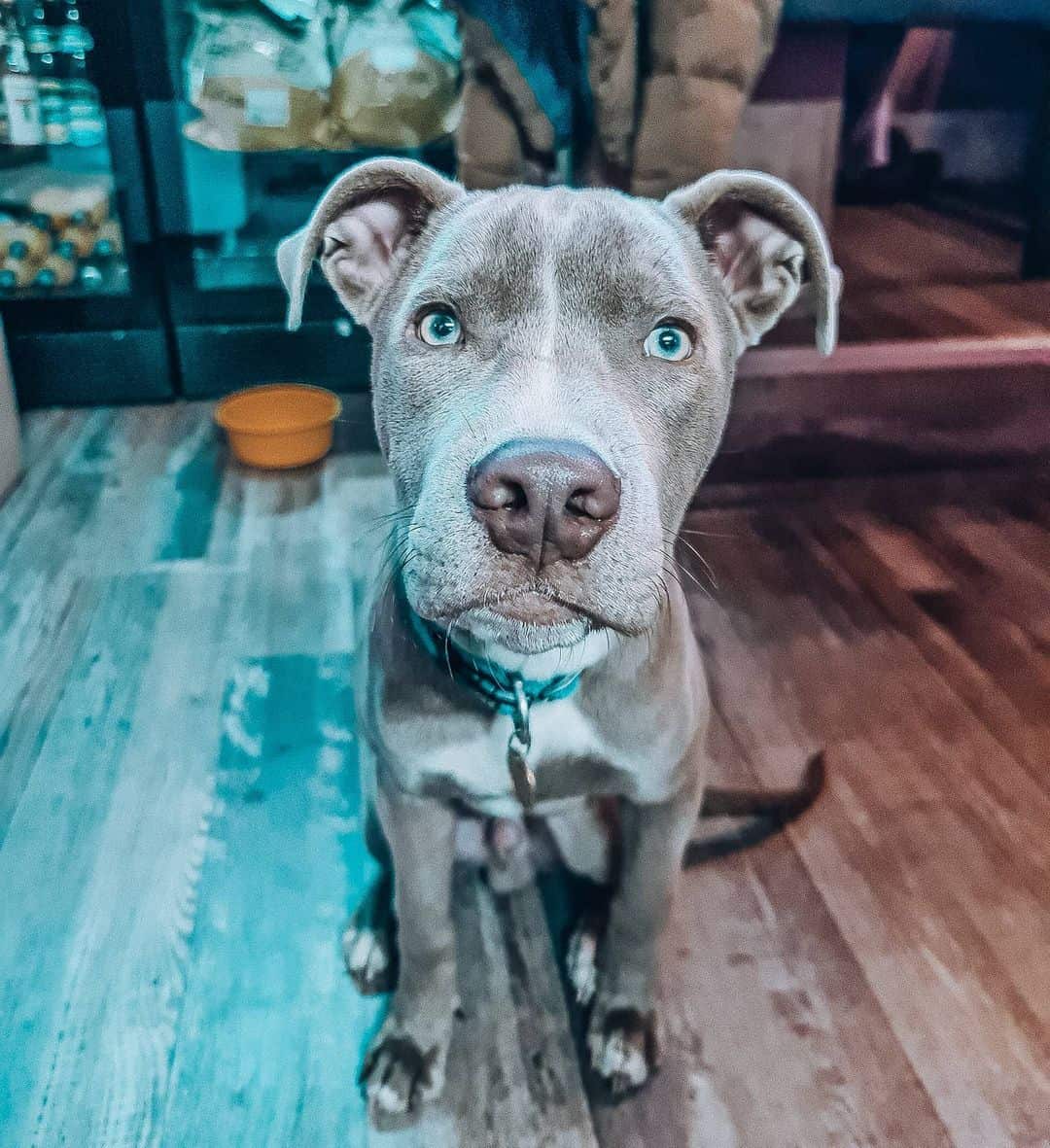
Photo from: @mr.melu
There is a tight bond between a Pitbull’s coat and blue eyes.
You can find blue-eyed Pitbulls with a brown, black, grey, or silver coat color. They’re also the rarest Pitties. The melanin levels are full-on black or are closer to the black pigmentation. Between these coat colors are also less likely to carry a merle gene.
Solid coats are the result of melanin levels. Eumelanin is a type of melanin, or a black pigment responsible for the black coat. But, genes like the merle gene can alter the production of eumelanin in a dog’s cells. These cell modifications don’t allow the production of a full black pigment, which results in shades of grey, brown, tan, and everything in between.
Grey Blue-Eyed Pitbull Vs White Blue-Eyed Pitbull VS Black Blue-Eyed Pitbull
A white Pitbull with blue eyes is prone to being a double merle Pittie as this gene not only causes the blue color of the eyes, but it also causes lack of pigmentation, which results in a white coat color. Disclaimer: white is not to be mistaken for albino.
Grey Pitbulls or black blue-eyed Pitbulls aren’t supposed to have double mere genes. Only if they carry white spots on their body is such a scenario possible.
Carrying a merle gene can cause the nose to become pink. However, it’s not an indicator of whether the dog is a merle or not because the pink might not show at all. The best way to detect whether the dog has merle genes or not is to conduct genetic testing since the chances of the dog having medical issues are very high.
Blue-Eyed Pitbull Puppies For Sale
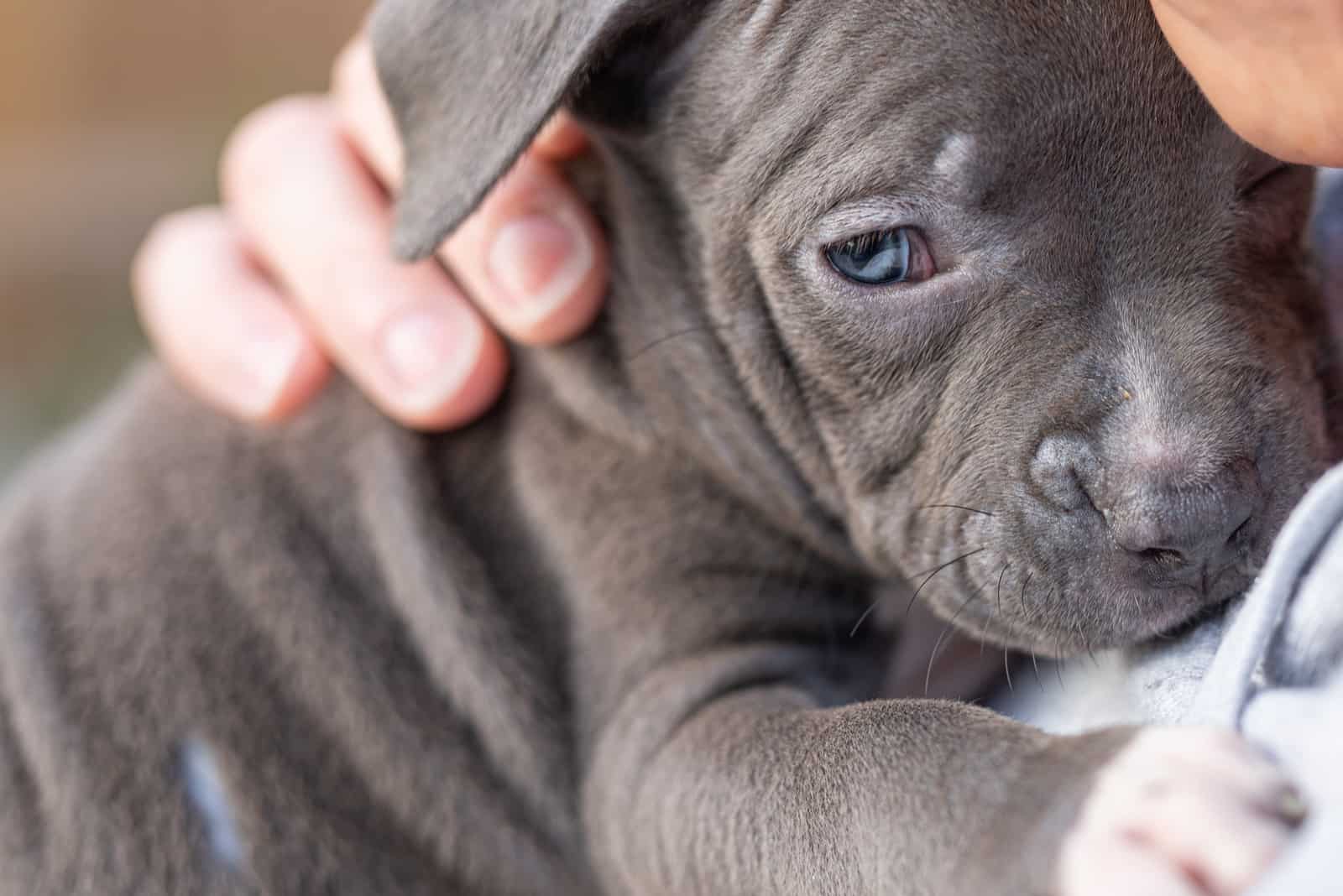
When buying a baby blue-eyed Pitbull, make sure you know if the dog’s personality fits your lifestyle. It’s an energetic breed, and you need to be prepared for its abundance of energy and friendly nature.
When buying a blue-eyed Pitbull, it’s of utmost importance to choose a healthy puppy. Whether you opt to adopt or buy from a reputable breeder, always ask to see health clearances if they’re available. A breeder who avoids showing you test results is not to be trusted.
But, where do you find a good Pitbull breeder?
The AKC Marketplace is a good starting point to find Pitbull puppies in your area. Baby Pitbulls are prone to deafness and blindness, especially puppies with the blue eye color. A good breeder should provide you test results from both parents as well as from your new doggie.
Blue Nose Pitbull With Blue Eyes
Blue nose Pitbull with blue eyes are rare dogs because of the coloring caused by a recessive gene. To express this recessive gene, breeders need two Pitbull parents that are blue in order to produce blue nose Pitbull puppies.
The blue color is caused by a diluted black pigment – eumelanin. It’s the same pigment that causes blue hair, nose color, and eye color.
Blue-Eyed Brindle Pitbull
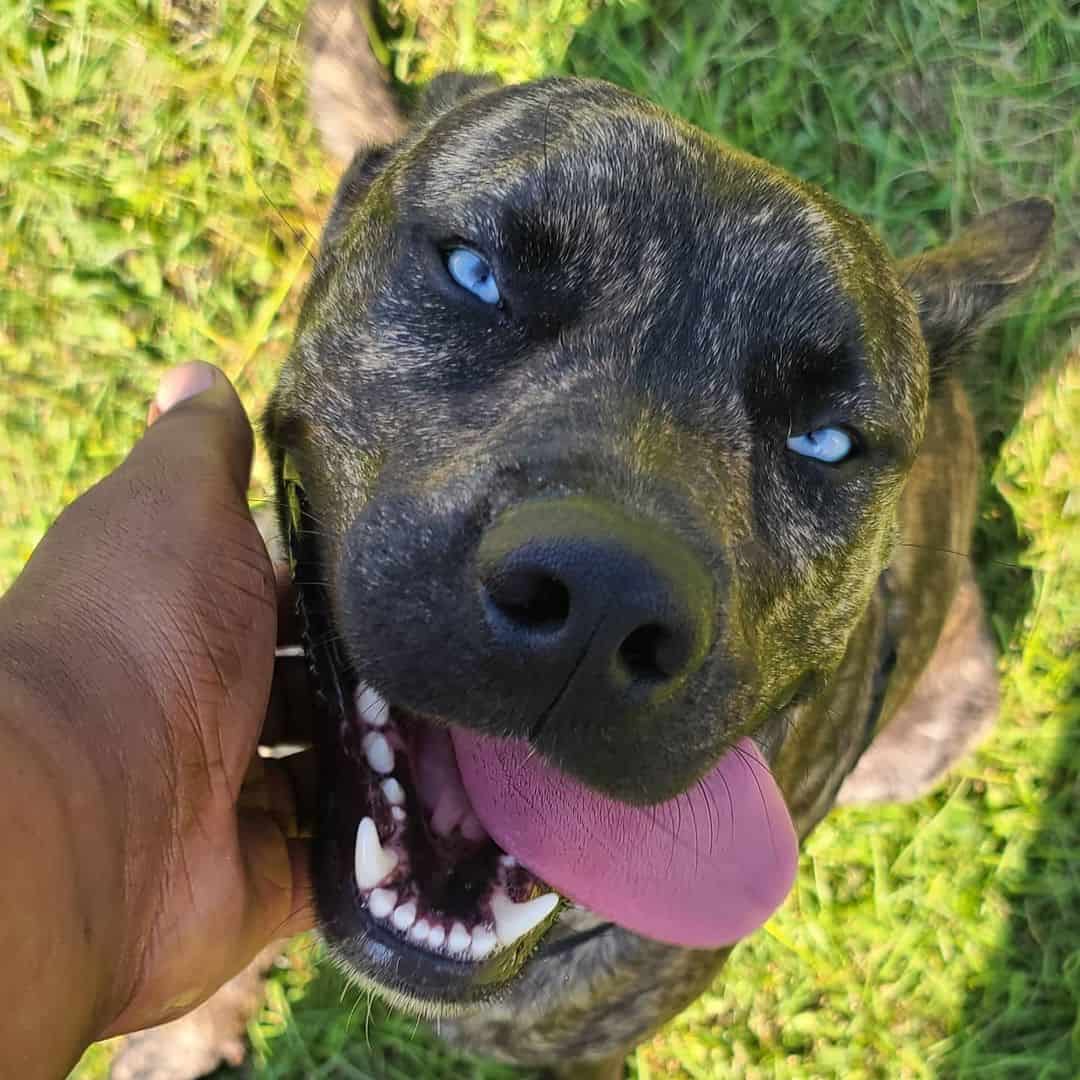
Photo from: @21que_stions
Brindle is one of the three recessive genes that dogs carry. Brindle describes the dog’s coat and tiger-stripe pattern. The base coat color is usually fawn, tawny brown, or dark brown.
The brindle coat color in Pitbulls can be alternating stripes or points of yellow and red or black and brown.
Normal brindle point coloration is mainly a darker coat color on top of a lighter base color. Reverse brindle point coloration is the opposite.
A blue-eyed brindle Pitbull is rare, not because of the brindling, but because of the unique blue eyes.
Red Nose Blue-Eyed Pitbull
Another Pitbull with rare genetic makeup is the red nose Pitbull with blue eyes.
Both Pitbull parents must have the recessive gene for their offspring to have the classic red nose look, which makes these Pitties so rare.
Red Nose Pitbulls got the title “best dogs for fighting” for a reason. They do have an athletic build that makes them larger than an average Pitbull, but still, they’re kind dogs that equally know how to love.
Are All Pitbulls Born With Blue Eyes?

Photo from: @gonzobuddy
All Pitbull puppies are born with blue eyes. This happens because the melanin production in the eyes doesn’t start until the puppies are a few weeks old.
Up to this point, a puppy’s eyes will be blue.
When Does The Eye Color Change?
Those adorable baby blues won’t stay blue for too long.
At three or four weeks old, most puppies’ eyes will start to operate like those of adults, similar to the development of their permanent eye color. The vast majority of dogs will end up with brown eyes. A lot of dog breeds like the German Shepherd, the Golden Retriever, or the Mastiff will have brown eyes, but a Siberian Husky, for example, will be an exception.
Your Pitbull pup will change eye color to a permanent one several weeks down the line. It takes 9 to 12 weeks from birth for the eye color to settle in and stay that way. Sometimes, the eye color change may appear as late as 16 weeks of age.
Pitbull eye colors can range from light brown to dark brown to amber, and to the rare permanent blue eye color.
What Does It Mean When A Pitbull’s Eyes Are Red?
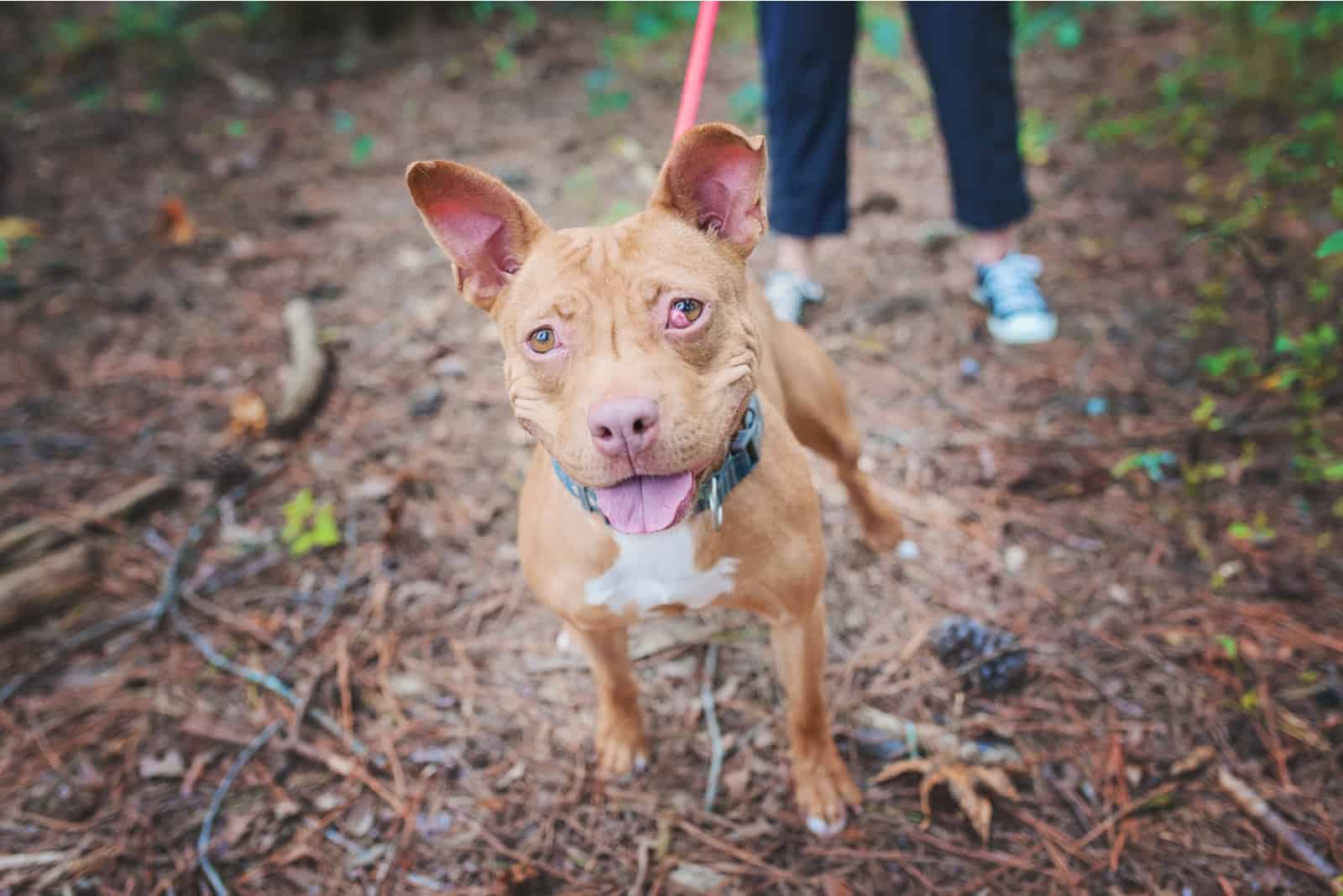
Your Pitbull pup can have red eyes. No, it’s not a result of the recessive gene or any other genetic mutation. Red eyes aren’t normal to begin with. It’s not an eye color; it’s a sign of numerous infections, allergies, or eye conditions like conjunctivitis, glaucoma, or dry eye.
Since Pitbulls are prone to serious eye conditions, it’s important to notify your vet as soon as you notice any redness in your Pitbull’s eyes.
Breeding Pitbulls With Blue Eyes
Some dog lovers and experts claim that breeding blue-eyed Pitbulls is unethical and inhumane.
The chances of having puppies with health issues increase when two merle dogs are bred together. Breeding such dogs will result in a double merle litter of puppies that are prone to genetic diseases, especially deafness and blindness.
Blue-eyed Pitbulls may produce healthy offspring, but their puppies have higher chances of being born with congenital health issues rather than puppies from single merle and non-merle parents.
It’s recommended to breed a merle Pitbull with a non-merle or non-cryptic merle Pitbull dog.
When breeding Pitbulls, always make sure that both parents are from healthy bloodlines. There is no difference in breeding regular Pitbulls or blue-eyed Pitbulls. The blue eyes don’t affect the breeding process.
In both cases, it’s important to wait until the female is 2 years old, and do it after her heat cycle. Never breed female Pitbulls in two consecutive heat cycles. The female needs time to recover, and when she does give birth, the litter may carry 5 to 10 Pitbull puppies.
Blue-Eyed Pitbull Price
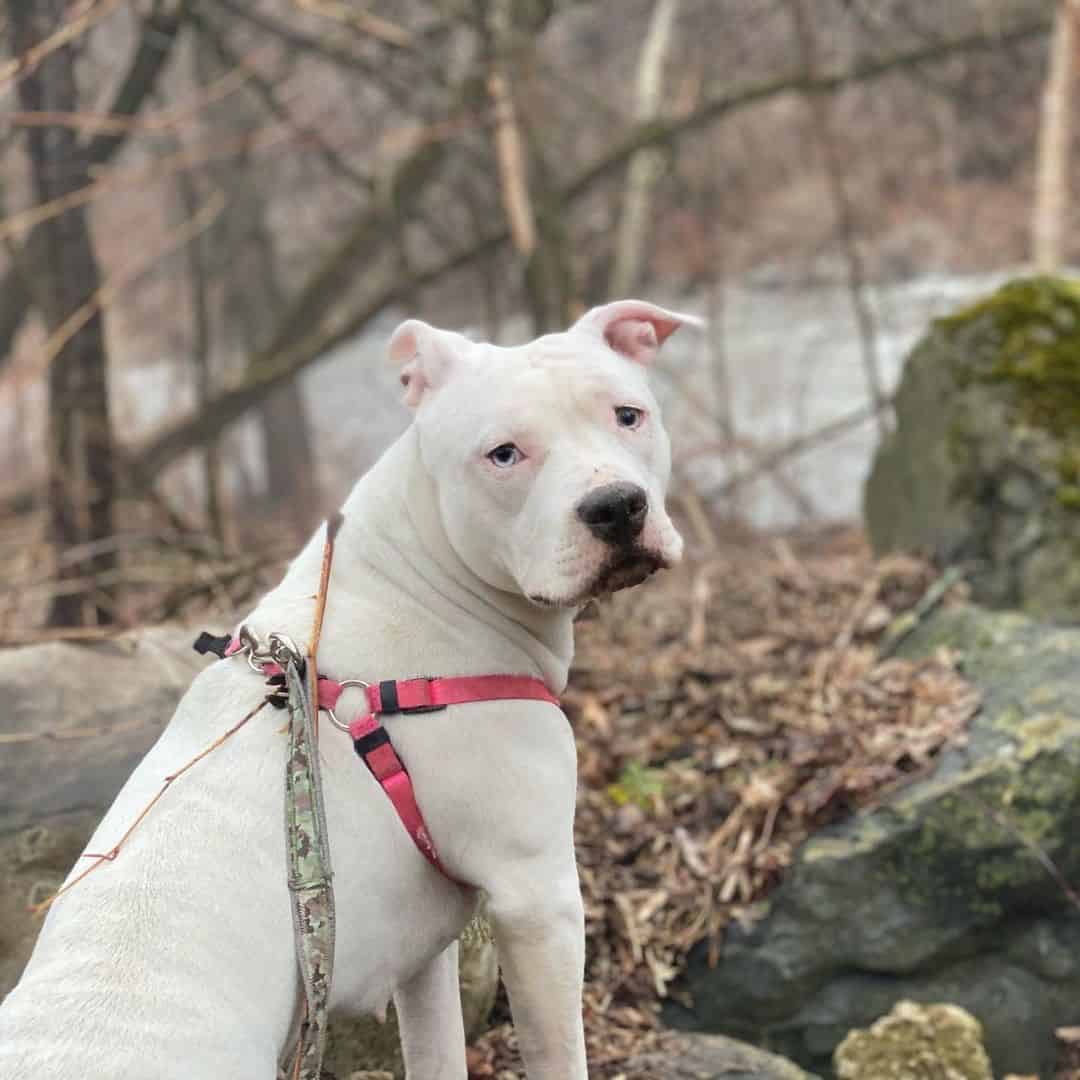
Photo from: @safiya.the.pitbull
Reputable breeders usually sell Pitbull puppies with good bloodlines anywhere from $2,000 to $20,000.
However, the price can be as low as $800 to $3,000, but only if you’re willing to risk the dog’s health.
Reputable breeders have a reason why their Pitbulls cost more. It takes a lot of money to keep the dogs healthy to breed. Since blue eyes are rare and unique, it’s normal to assume that such Pitbull puppies will cost more.
Should You Get A Pitbull With Blue Eyes?
Generally speaking, all Pitbulls are amazing pets, no matter their bad publicity. These dogs are loving and loyal, very family-oriented pups that thrive to be a part of the family. All Pitbulls, including the American Bully and the American Staffordshire Bull Terrier, are big cuddle bears, quite affectionate with kids and adults.
Pitbulls are very energetic dogs that need lots of exercise. If you don’t have much spare time to exercise your Pitbull pup, then you might want to consider another breed.
Being closed in small apartments might trigger destructive behavior in your Pittie, so exercise and training time is highly important for your Pitbull. A healthy Pitty is a happy Pitty.
So, should you get a blue-eyed Pitbull?
The biggest con and the biggest downfall of owning a Pitbull with blue eyes is the many health concerns that we have already talked about.
However, if you find a healthy puppy and take it to regular vet checkups, then you might find that your blue-eyed Pitbull is as healthy as an American Bulldog, an American Staffordshire Terrier, or any other regular Pitbull.
Read Next: Dog Eye Color Chart: 7 Mesmerizing Shades


